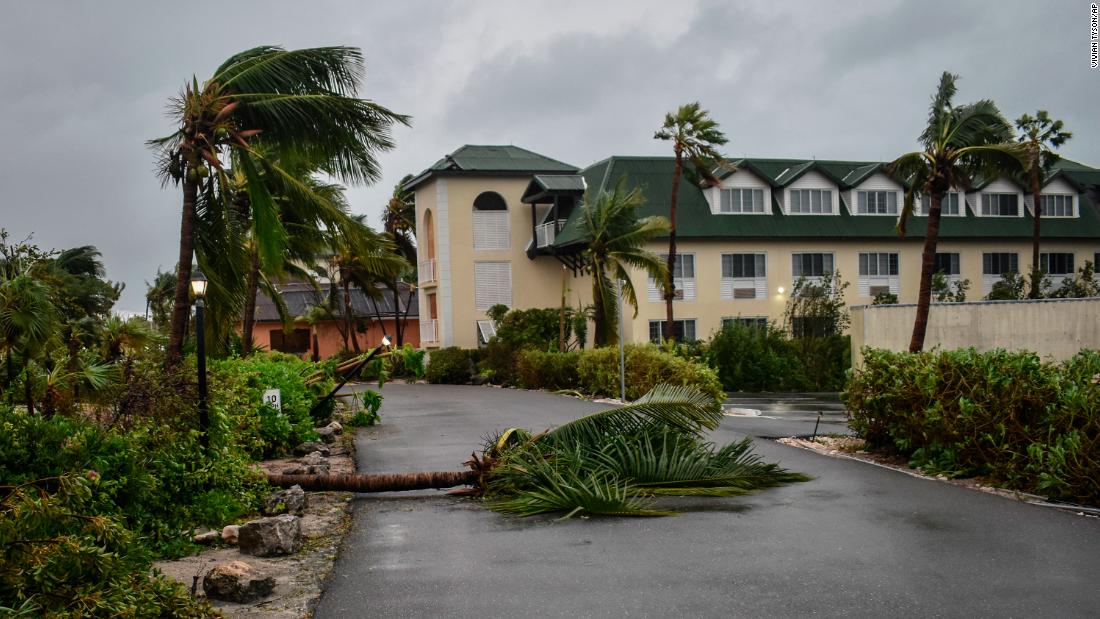
Water is the top concern for residents like Carlos Vega, whose town of Cayey in the mountains of east-central Puerto Rico faced not only utility outages but also partially collapsed roads — an effect of the major flooding and more than 2 feet of rain that parts of Puerto Rico were hit with.
“(Being without) power … we can face that and we can deal with that. The biggest concern is with our water. Can’t live without water,” Vega told CNN on Tuesday.
Fiona also whipped parts of the Turks and Caicos islands on Tuesday with sustained winds of almost 125 mph, officials said. That left many areas without power, including on Grand Turk, South Caicos, Salt Cay, North Caicos and Middle Caicos, said Anya Williams, the deputy governor of the islands.
No deaths or serious injuries had been reported in Turks and Caicos as of Tuesday evening, Williams said.
Fiona’s flooding especially left critical infrastructure damage in Puerto Rico and then the Dominican Republic, which the storm crossed Monday. More than 1 million utility customers in the Dominican Republic had no water service as of Wednesday morning, and more than 349,000 customers were without power, according to Maj. Gen. Juan Méndez García, director of the country’s emergency operations center.
The power outages come as parts of the Caribbean face stifling heat. Heat indices — what the air feels like when combining temperature and humidity — of 105 to 109 degrees are expected Wednesday in north-central, northwestern and western portions of Puerto Rico, the National Weather Service said.
Storm presses north and could threaten Bermuda and Atlantic Canada
“Fiona is forecast to be a hurricane-force cyclone through Saturday,” the hurricane center said.
Though the storm isn’t expected to track near the US East Coast, it could generate onshore waves of 8 to 10 feet there over the weekend, CNN meteorologist Chad Myers said Wednesday.
“It’s not a good weekend to go to the shore and get in the water — it’s time to stay out of the water,” Myers said of the East Coast.
‘We can’t take it any longer’
Many in the Dominican Republic and Puerto Rico still are grappling with Fiona’s aftermath and will likely face a prolonged relief and recovery process.
In Nizao, a small city in southern Dominican Republic, a woman tearfully told CNN affiliate Noticias SIN that Fiona’s winds destroyed her home.
“Thank God my girls (are) safe. I managed to cover them with something and block them with a washing machine,” she told Noticias SIN this week.
Another woman in Nizao who was clearing mud from belongings told Noticias SIN that she was frustrated because flooding frequently damages the region. This week, she left all belongings behind when floodwater encroached, she said.
“We can’t take it any longer. Every year we lose our bed, clothes, food, everything,” the second woman told Noticias SIN.
More than 610 homes in the Dominican Republic have been destroyed, and some communities were cut off from aid due to the storm, said García, the nation’s emergency operations center director.
Restoration crews face challenges
The governor expected “a large portion of the population” would have power restored by late Wednesday, with the exception of the island’s southern region, which has suffered the most severe damage, he said Tuesday.
But restoration crews faced challenges: Many lines thought to have been repaired were temporarily knocked back offline because of various equipment issues, according to Josué Colón, executive director of the Puerto Rico Electric Power Authority.
Crews could also encounter issues that require a pause in work so that an already impaired grid is not overloaded, a spokesman for the power provider, LUMA Energy, said Wednesday.
“The community there … (had) severely impacted roads, and bridges were damaged. Water was flooding the streets, and … other parts of the community (were) inaccessible,” Criswell said during a news conference Wednesday.
“But I also saw a resilient Puerto Rico,” she said. “I met with a woman named Anna, who opened up her own home in her own driveway to help create a path for the community. With the bridge that was washed away, her home became that pathway to help give food and water to the rest of her community.”
The storm is a catastrophic blow to Puerto Rico, which was still recovering in some areas from when Hurricane Maria ripped through the island in 2017, inflicting widespread infrastructure damage and destroying homes.
The damage caused by Fiona is “devastating” and “catastrophic” in the island’s center, south and southeast regions, Pierluisi said Tuesday.
Across the island, more than 800 people were housed in dozens of shelters Wednesday, according to Puerto Rico’s Housing Secretary, William Rodriguez.
CNN’s Leyla Santiagio in Puerto Rico and CNN’s Robert Shackelford, Jamiel Lynch, Amanda Musa, Chris Boyette, Taylor Ward and Geneva Sands contributed to this report.
